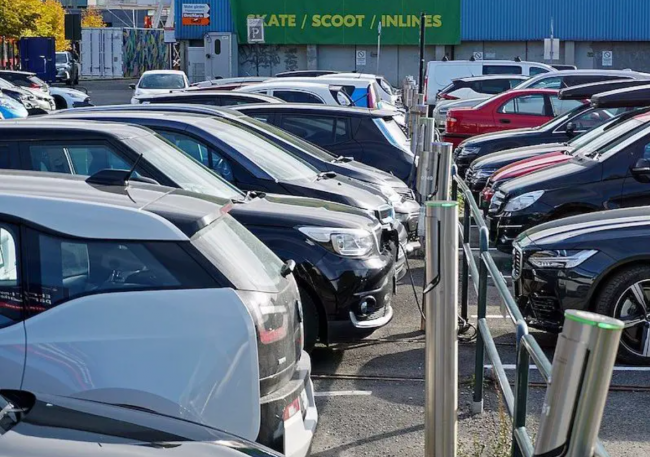Articles Menu

May 15, 2024
Canada faces an investment gap of more than C$600 billion to complete the shift to a zero-carbon road transportation system by 2050, but the effort will more than pay for itself, a new analysis shows.
Much of the new investment will depend on comparatively small public spending on electric vehicle infrastructure that must increase 23-fold by 2050 to enable the rest, the Corporate Knights research department concludes in a presentation delivered at an electric mobility conference earlier this month.
“To decarbonize road transportation in Canada by 2050, it will take up to $666 billion in capital investments,” states the May 2 presentation by Corporate Knights CEO Toby Heaps and Research Director Ralph Torrie to EV & Charging Expo 2024 in Toronto, hosted by Electric Autonomy Canada. Some 60% of that total will come from households.
But current trends are running far behind the target, Heaps and Torrie warned. Today’s levels of incremental investment—the added dollars Canadians would put into electrifying their vehicles—extrapolate to only $59 billion by mid-century, including $48 billion from households and $8.5 billion from commercial fleets.
The analysis is the latest output from Corporate Knights’ Climate Dollars project, which reported last month that actual federal investment in green technologies and infrastructure has fallen $14 billion behind what the government promised, for a 30% shortfall since 2015. Climate Dollars is now addressing the decarbonization gap sector by sector, beginning with the 18% of greenhouse gas emissions that come from the tailpipes of the country’s 22.5 million personal and 5.9 million commercial vehicles.
“The road transportation system is 10% of GDP and the other 90% depends on it,” the presentation declares. “In the 5% of the year when their cars are not parked, Canadians drive more than 400 billion kilometres—over 2,500 times the distance to the sun.”
Decarbonizing that activity will shift the investments Canadians are already on track to make in the vehicles they buy. In Corporate Knights’ decarbonization scenario, household investments in EVs grow eight-fold by 2050, while electrification extends to 85% of light, 80% of medium, and 70% of heavy trucks.
Despite the added up-front cost, Canadian drivers stand to save more than $1 trillion on the cost of energy, maintenance, and the carbon their vehicles they would otherwise emit—not including the gargantuan health costs of tailpipe emissions.
Those savings are “electrifying,” Torrie told The Energy Mix. “The transportation savings are more than enough to pay for the whole transition in that sector. There are logistical and financing challenges, but the fundamental economics of doing this are sound.”
But all of that depends on the “relatively small contribution” from public charging that only accounts for about 5% of the total spending, but has to increase 23-fold by 2050, producing peak investment of $1.4 billion in 2035 and a total of 563,000 public charges by 2050, one for every 50 EVs.
EV infrastructure investment in Canada is currently on track for 100,000 chargers by 2050 and peak investment of $108 million in 2035.
“The public charging network is a relatively small contribution to the total investment requirements for electrifying the transportation sector,” Torrie said. “The vehicles are a much bigger deal.”
But “the public charging network is critically important for the success of the entire enterprise. It has to stay ahead of the curve so that a lack of confidence in the charging network doesn’t become a barrier to accelerated EV purchases.”
All told, the Corporate Knights calculations have Canadian households and businesses spending an average $26 billion per year on electrification. But “Canadian households and firms already spend more than $225 billion per year for the road transportation system, including the vehicles, the fuel, the insurance, the parking, and the roads and other related infrastructure,” Torrie said. So the “electrification premium” is only about 10% of the total—and that cost comes down as the process of electrification proceeds.
“If we accelerate the pace at which we’re moving, the unit costs will come down for the electric vehicles, for the housing retrofits, for the changes in the electricity grid that we need to support the distributed renewable system that is coming, and so on throughout the system,” he explained. “So to bring down the cost of decarbonizing our economy, we need to speed up the pace at which we do it.”
Torrie added that Canada will see a “very steep acceleration” in EV market share once vehicle prices come down.
“You can sense the pent-up demand for them in the explosion in inexpensive electric bicycles, scooters, and other small conveyances that provide affordable, convenient, electric transportation in our cities,” he said. “Fundamentally, electric vehicles are less complicated, have many fewer parts, and cost less to fuel and maintain than the combustion vehicles they are replacing.”
Today’s EV prices shut out lower- and middle-income households, but “electric vehicles do not have to cost this much, and in fact that they do not cost this much in many parts of the world,” as China in particular has shown.
“When the dam that is holding back these less expensive vehicles finally bursts, it will unleash a flood of affordable EVs in the North American market,” Torrie said.
[Top photo: Mario Roberto Durán Ortiz/wikimedia commons]